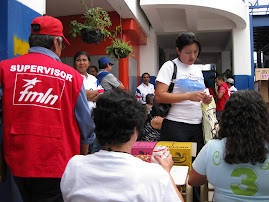Wednesday, January 14, 2009
Election observers today had a choice of a number of field trips to various locales. I chose to visit two very different municipalities where we met with the mayor of each one. Our first visit was with Milagro Navas, the ARENA mayor of Antiguo Cuscatlan. ARENA is the far right political party which is in control of the central government at this time. However, Mayor Navas has overseen the development of a model community. She is fortunate that there is much wealth here, and she has chosen to invest in the community rather than pocket the wealth for her own benefit. Three embassies are located in the community, there are a large number of industries, unemployment is the lowest in the country and they have good schools. In order for a new business to locate here, they must agree that 50% of their employees come from this municipality. She claims that her municipality has the best water in the country and that they take care of trees and the land.
When asked how she came to have such power as a woman in a macho society, she said that she has to be a woman of strength as she works only with men. She said she was selected as the best mayor in the entire country, is Treasurer of the mayors association in El Salvador and is General Secretary of the organization of mayors of Central America.
As with most Salvadorans, her experience during the Civil War from 1980-1992 has influenced her political beliefs. Her family were large land owners in the area of Suchitoto at the beginning of the war. Part of their land was taken by the guerrilla forces, and they were forced to leave the area. She is opposed to the teaching of Oscar Romero and believes the church and priests should have nothing to do with politics.
The municipality of Suchitoto offers a distinct contrast to that of Antiguo Cuscatlan. We met with Mayor Javier Martinez of the leftist FMLN (Faribundo Marti Liberacion Nacional) political party. Mayor Martinez has also developed a model community but with far fewer resources to work with than Mayor Nivas. Its economy is primarily based on agriculture though tourism is growing here. Several women's cooperatives have been established in recent years. These cooperatives create embroidered textiles or candies and jellies made from native fruits. Others have revived the ancient art of dying cloth with indigo or making candles, shampoo and natural soaps. The municipality receives only 2% of its budget from the Salvadoran government. The rest comes from the international community from countries such as Spain.
Because Suchitoto was a main area of conflict during the civil war, many people left at that time and social structures such as schools, homes and roads were destroyed. Repopulation of the area began in 1989, and the first development plan was made in 1995. At first only 10% of families had electricity and 13% had potable water. Now 94% have electricity and 93% have water.
The municipality has a recycling program and sewage treatment. I was somewhat surprised that they have a 2030 Plan. Included in this plan for the future is putting pressure on the government of San Salvador and surrounding communities to clean up the river that flows into Lake Suchitlan, a beautiful but highly polluted lake near the city of Suchitoto.


























No comments:
Post a Comment